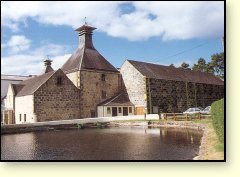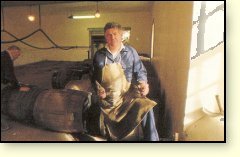
 |
|
Location: Knockando, Aberlour, Banffshire AB38 7RY.
Roads: On B9102
Hours: All year, 9.30am - 4.30pm, Mon - Fri
Easter - September, Sat as above
July - September: Sun 11.00am - 4.00pm
Group bookings by appointment
Reception centre, shop, exhibition, coffee shop, picnic area
Phone: 01340-810498
Fax: 01340-810491
|
When John Cumming first licensed his Cardhu distillery in 1824, he had a string of convictions as a whisky smuggler behind him. Such brushes with the law seem to have been the equivalent then of parking on a double yellow line today. They even became a kind of alternative pedigree and at Cardhu the court judgements are framed and hung proudly on the wall of the distillery manager’s office.
Cumming took a lease at Cardhu farm in 1811 and made whisky from the outset. He was a classic example of the tenant-farmer for whom distilling was a related part-time farming activity using barley, peat and water from the land to good productive ends. His wife, Helen, was an inspired partner. She looked after the mashing and fermenting and always succeeded in disguising it as bread-making if the Excise officers happened by. She would sit them down for tea and bannocks and, while they ate, would slip out and fly a red flag from the barn – a prearranged signal to her neighbours to hide their distilling equipment since there were revenue men in the area. She lived to the age of 95, still involved with whisky, and is remembered selling it at a shilling a bottle through the kitchen window at Cardhu farm. Even after being licensed, Cardhu’s whisky was produced on this simple artisanal basis because Cumming liked the status of being one of the smallest distilleries in Scotland but also one of the best. His son and daughter-in-law, Elizabeth, kept faith with his approach even after he died, but finally, in 1884, the worn-out equipment was replaced by the new Cardhu distillery. It was situated on additional land leased in perpetuity by Elizabeth, now a widow, who was a talented, dynamic woman and probably the most accomplished woman distiller of her time. Among the plant she sold off were a pair of much-patched and very thin-skinned pot-stills that went to a new distiller called Mr. Grant for £120. He was optimistic that he could do well with the whisky he was going to produce and his distillery was to be called Glenfiddich.
By the 1890s, Cardhu had become the principal malt in the blends produced by John Walker & Co., Kilmarnock. In 1893 Cardu was sold to Walker’s thus securing supplies for the blends which have become the biggest selling brands in the world with Cardhu remaining the ‘heart’ of the blend.

At work in the filling-store attached to Cardhu.
|
The Mannoch Hill nearby provided both the spring water and the peat with which Cardhu whisky was made. In the days when it was illicitly produced, small kegs of it were carried on ponies, often at night, over the Mannoch Hill and down into Forres and Elgin where there was never any shortage of customers.
In the 1920s, the distillery workers’ cottages had running water, indoor toilets and electric light long before such amenities were widespread in the countryside. A cask of hot water was placed outside the boiler room every morning from which families drew amounts as required. Elizabeth Cumming’s son, John, ran the distillery for Walker’s and, for a time, he and the local laird owned the only two motor cars to be seen in the village.
Today the office, the malt-barns and the kiln, including pagoda heads, remain of Elizabeth Cumming’s ‘New’ Cardhu of 1884; the rest of the distillery dates from major refurbishment carried out in 1960. In the 1920s experiments with a form of steam-heating of the stills took place but it was found to be too expensive and discontinued. The technology was better, of course, half a century later and in 1971 Cardhu’s three pairs of stills were converted to heating by internal steam coils.
The Whisky
Cardhu is a highly approachable malt – smooth, sweet, mellow and uncomplicated. It has good body and length. It is widely available at 12 years old and 40% vol. with no special editions or older versions, either from the proprietors or the independents. The malt is an important constituent of the Johnnie Walker blends.
Source of water
Mannoch Hill and Lyne Burn Springs